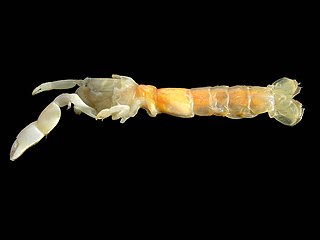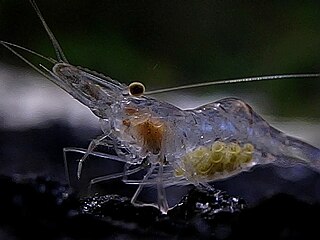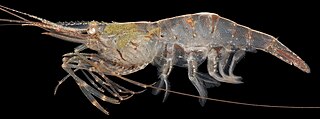
The Cape lobster, Homarinus capensis, is a species of small lobster that lives off the coast of South Africa, from Dassen Island to Haga Haga. Only a few dozen specimens are known, mostly regurgitated by reef-dwelling fish. It lives in rocky reefs, and is thought to lay large eggs that have a short larval phase, or that hatch directly as a juvenile. The species grows to a total length of 10 cm (3.9 in), and resembles a small European or American lobster; it was previously included in the same genus, Homarus, although it is not very closely related to those species, and is now considered to form a separate, monotypic genus – Homarinus. Its closest relatives are the genera Thymops and Thymopides.

Amphionides reynaudii is a species of caridean shrimp, whose identity and position in the crustacean system remained enigmatic for a long time. It is a small planktonic crustacean found throughout the world's tropical oceans, which until 2015 was considered the sole representative of the order Amphionidacea, due to unusual morphological features. Molecular data however confirm it as a member of the caridean family Pandalidae, and the confusion of morphology is because only larval phases have so far been studied.

Palaemon is a genus of caridean shrimp in the family Palaemonidae.
Palaemon antrorum, also known as the Balcones cave shrimp and the Texas cave shrimp, is a species of palaemonid shrimp endemic to Texas. It is listed as an endangered species on the IUCN Red List, and as a Species of Concern by the United States Endangered Species Act.

Palaemon cummingi, known as the Squirrel Chimney Cave shrimp or the Florida cave shrimp, is a threatened species of cave-dwelling shrimp in the family Palaemonidae. P. cummingi has been observed in one sinkhole called Squirrel Chimney in Alachua County, Florida near Gainesville. Although exact numbers are unknown, it is speculated that the current P. cummingi population is very small.

Gilvossius tyrrhenus is a species of thalassinidean crustacean which grows to a length of 70 mm (2.8 in). It lives in burrows in shallow sandy parts of the sea-bed in the Mediterranean Sea and northern Atlantic Ocean. It is the most common thalassinidean in the Mediterranean, and has been used as bait by fishermen for at least 200 years.

Palaemon serratus, also called the common prawn, is a species of shrimp found in the Atlantic Ocean from Denmark to Mauritania, and in the Mediterranean Sea and Black Sea.

Palaemon paludosus, coommonly known as ghost shrimp, glass shrimp, and eastern grass shrimp, is a species of freshwater shrimp from the southeastern United States.
Fenner Albert Chace Jr. was an American carcinologist.

Palaemon vulgaris, variously known as the common American prawn, common grass shrimp, marsh grass shrimp or marsh shrimp, is a common species of shrimp in the western Atlantic Ocean from Cape Cod Bay to the Gulf of Mexico. Adults grow to less than 5 cm (2.0 in) long, and are transparent except for some orange pigmentation on the eyestalks.

Crustaceans may pass through a number of larval and immature stages between hatching from their eggs and reaching their adult form. Each of the stages is separated by a moult, in which the hard exoskeleton is shed to allow the animal to grow. The larvae of crustaceans often bear little resemblance to the adult, and there are still cases where it is not known what larvae will grow into what adults. This is especially true of crustaceans which live as benthic adults, more-so than where the larvae are planktonic, and thereby easily caught.

Pandalus montagui is a species of cold-water shrimp in the family Pandalidae. It is the type species of the genus Pandalus and is variously known as the pink shrimp, Aesop shrimp and Aesop prawn.
Microphallus turgidus is a widespread and locally common flatworm parasite in New Zealand lakes and streams. Multilocus allozyme genotype data show that Microphallus turgidus is a single outbred species with high levels of gene flow among South Island populations. Microphallus turgidus is commonly found in the abdominal muscles of grass shrimp.

Trachysalambria curvirostris is a species of prawn that lives in shallow waters of the Indo-West Pacific. It is one of the most important species targeted by prawn fishery, with annual harvests of more than 300,000 t, mostly landed in China.

Palaemon varians, known as the common ditch shrimp, river shrimp or Atlantic ditch shrimp, is a shrimp found from the Baltic Sea and the British Isles to the western Mediterranean Sea. It reaches up to 5 cm (2.0 in) in length and is never found in fully marine conditions, instead living in brackish water.

Albunea carabus is a rare species of "sand crab" or "mole crab" in the genus Albunea. It lives in shallow, turbulent waters in sandy areas of the tropical eastern Atlantic Ocean and the Mediterranean Sea.

Palaemon kadiakensis, commonly known as the Mississippi grass shrimp, is a species of freshwater shrimp from the central United States, specifically the Mississippi River Basin.

Palaemon pandaliformis is a species of shrimp of the family Palaemonidae. It is found along with Palaemon northropi.

Palaemon macrodactylus is a species of shrimp of the family Palaemonidae.

Feeder shrimp, ghost shrimp, glass shrimp, grass shrimp, river shrimp or feeder prawns are generic names applied to inexpensive small, typically with a length of 1 to 3 cm, semi-transparent crustaceans commonly sold and fed as live prey to larger more aggressive fishes kept in aquariums.
















